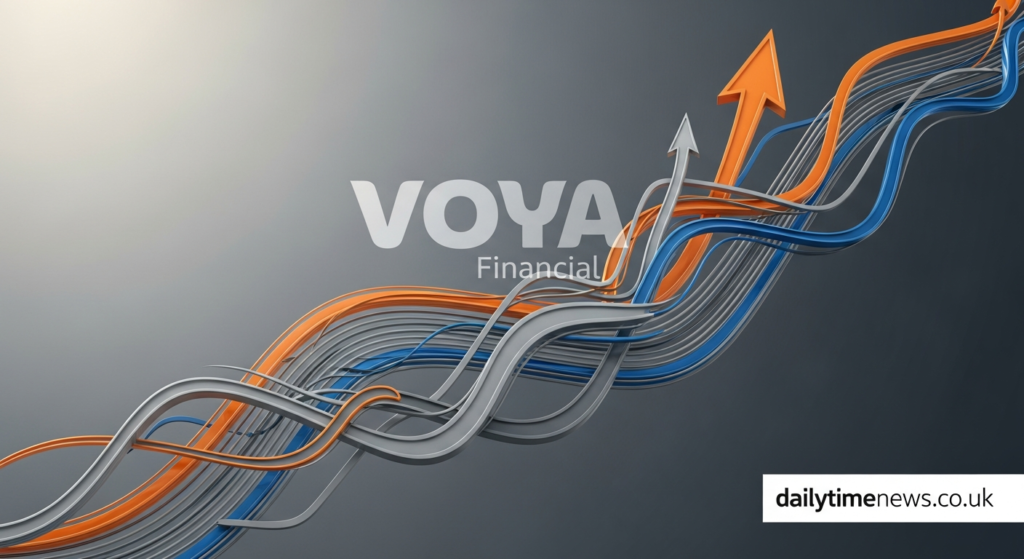Ultimate Voya Financial Guide for Smart Retirement Planning

Introduction
Planning for retirement can feel overwhelming. You’re bombarded with options, confusing terminology, and pressure to make decisions that will affect your entire future. That’s where understanding companies like Voya Financial becomes crucial for your financial wellbeing.
Voya Financial stands as one of America’s leading retirement, investment, and insurance companies. With millions of customers and billions in assets under management, they’ve built a reputation in the financial services industry. But is Voya Financial the right choice for your retirement planning needs?
In this comprehensive guide, you’ll discover everything about Voya Financial. We’ll explore their services, investment options, customer experience, fees, and how they compare to competitors. Whether you’re just starting your career or approaching retirement, understanding what Voya offers helps you make informed decisions. By the end of this article, you’ll know whether Voya Financial aligns with your financial goals and retirement dreams.
What Is Voya Financial?
Voya Financial is a Fortune 500 company specializing in retirement, investment, and insurance solutions. Headquartered in New York City, they serve approximately 14 million individual and institutional customers. The company manages about $650 billion in total assets, making them a significant player in the financial services sector.
The company’s history dates back to 1991, though it operated under different names before becoming Voya Financial in 2014. The rebranding represented a fresh start and clearer identity. The name “Voya” suggests voyage or journey, reflecting their mission to guide customers through their financial lives.
Voya operates primarily through employer-sponsored retirement plans. If your workplace offers a 401(k) or 403(b), there’s a chance Voya administers it. They also provide individual retirement accounts, life insurance, annuities, and investment management services.
What sets Voya apart is their focus on workplace benefits. Rather than being a retail bank you visit on the corner, they work behind the scenes with your employer. This business model means many people use Voya Financial services without initially choosing them directly.
Core Services Offered by Voya Financial
Understanding what Voya Financial offers helps you evaluate whether their services meet your needs. Let’s break down their main product categories and what each means for you.
Retirement Plans
Voya’s bread and butter is retirement plan administration. They manage 401(k) plans, 403(b) plans for non-profits and educational institutions, and 457 plans for government employees. If you’re contributing to your workplace retirement plan, Voya might be handling those investments.
Their retirement platform includes various investment options, from conservative bond funds to aggressive stock funds. You can typically choose target-date funds that automatically adjust as you approach retirement. The platform also offers managed account services where professionals make investment decisions for you.
Voya provides tools and calculators to help you determine if you’re saving enough. These resources estimate your retirement needs based on current savings, expected Social Security benefits, and lifestyle goals. While not perfect, they offer useful starting points for retirement planning.
The company also handles plan loans and hardship withdrawals when participants need access to funds. While accessing retirement money early isn’t ideal, Voya makes the process relatively straightforward when necessary.
Individual Retirement Accounts
Beyond employer plans, Voya Financial offers traditional and Roth IRAs. These accounts let you save additional money for retirement with tax advantages. Traditional IRAs may provide tax deductions now, while Roth IRAs offer tax-free withdrawals in retirement.
The investment options within Voya IRAs mirror those in workplace plans. You’ll find mutual funds, exchange-traded funds, and sometimes individual stocks and bonds. The selection varies based on the specific IRA product you choose.
Rollover IRAs represent another important service. When you leave a job, you can roll your old 401(k) into a Voya IRA. This consolidates accounts and potentially gives you more investment choices. Many people prefer managing one IRA instead of multiple old 401(k) accounts scattered across former employers.
Insurance Products
Voya Financial provides various insurance products designed to protect you and your family. Life insurance options include term life, which covers you for a specific period, and permanent life insurance, which lasts your entire life while building cash value.
Disability insurance replaces a portion of your income if you become unable to work due to illness or injury. Since most people depend on their paychecks, disability insurance prevents financial catastrophe during health crises. Voya offers both short-term and long-term disability coverage.
They also sell annuities, which are insurance products that provide guaranteed income streams. Fixed annuities offer predictable payments, while variable annuities tie payments to investment performance. Annuities can be complex, so understanding their fees and features before purchasing is essential.
Investment Management
For those with significant assets, Voya Financial offers investment advisory services. Professional advisors create personalized investment strategies based on your goals, risk tolerance, and time horizon. This service typically requires minimum account balances and charges ongoing management fees.
Their investment approach emphasizes diversification across asset classes. You might hold stocks, bonds, real estate investments, and alternative investments. The exact mix depends on your individual circumstances and the advisor’s recommendations.
Voya also provides access to institutional investment options not available to individual retail investors. These might include specialized funds or investment strategies with lower costs than retail alternatives.

How Voya Financial Retirement Plans Work
If your employer offers a Voya Financial retirement plan, understanding how it works maximizes your benefits. Let’s walk through the typical experience and what you need to know.
Enrollment and Setup
When you become eligible for your employer’s retirement plan, you’ll receive information about enrolling. Voya provides online portals, phone support, and sometimes in-person meetings to help with setup. The process usually involves choosing your contribution percentage and selecting investments.
Many employers now use automatic enrollment. You’re automatically signed up at a default contribution rate, typically 3% of your salary. You can always increase, decrease, or stop contributions, but automatic enrollment helps people who might otherwise never start saving.
You’ll need to designate beneficiaries who receive your account balance if you die. This crucial step ensures your money goes to intended recipients. Review and update beneficiaries after major life changes like marriage, divorce, or having children.
Making Contributions
Contributions come directly from your paycheck before you ever see the money. This automatic deduction makes saving painless and consistent. You won’t miss money you never had in your checking account.
Many employers offer matching contributions. For example, they might match 50% of your contributions up to 6% of your salary. This is free money. Always contribute at least enough to capture the full employer match. Leaving matching money on the table is like refusing part of your salary.
Contribution limits change annually. For 2024, you can contribute up to $23,000 to a 401(k) if you’re under 50. Those 50 and older can add another $7,500 in catch-up contributions. These limits apply across all your 401(k) plans, not per employer.
Investment Options and Choices
Voya Financial retirement plans typically offer 15 to 30 investment options. This range provides enough variety without overwhelming participants. Options usually include stock funds, bond funds, target-date funds, and sometimes a stable value fund.
Target-date funds simplify investing. Choose the fund with a date closest to when you’ll retire. The fund automatically becomes more conservative as that date approaches. If you’re not comfortable selecting individual funds, target-date funds offer reasonable default choices.
If you prefer building your own portfolio, you can mix different funds. A common approach allocates money across large-cap stocks, small-cap stocks, international stocks, and bonds. The exact percentages depend on your age and risk tolerance.
Some plans offer brokerage windows allowing access to thousands of additional investments. This option appeals to experienced investors wanting more choices. However, most people find the standard lineup sufficient for their needs.
Monitoring and Adjusting
Voya’s online portal and mobile app let you check your account anytime. You’ll see your balance, recent contributions, investment performance, and projected retirement income. Regular monitoring helps you stay on track toward your goals.
Rebalancing involves adjusting your investments back to target percentages. If stocks perform well, they might grow to represent a larger portion of your portfolio than intended. Rebalancing sells some stocks and buys other assets to restore your desired mix.
Many plans offer automatic rebalancing quarterly or annually. This feature prevents your portfolio from becoming too risky or conservative over time. If your plan doesn’t offer automatic rebalancing, consider doing it manually once or twice yearly.
Understanding Voya Financial Fees
Fees significantly impact long-term investment returns. Even small percentage differences compound dramatically over decades. Understanding what you pay helps you evaluate if you’re getting good value.
Administrative Fees
Plan administrative fees cover recordkeeping, customer service, and compliance costs. Your employer might pay these fees, or they might come from participant accounts. Typical administrative fees range from 0.25% to 1.0% of assets annually.
Some plans charge flat dollar amounts per participant instead of percentage-based fees. This approach can benefit people with larger balances but costs more for those with smaller accounts. Check your plan documents or fee disclosure statement to see how your plan handles administrative fees.
Investment Management Fees
Each mutual fund or investment option charges its own management fee, called an expense ratio. These fees pay fund managers, analysts, and operating expenses. Expense ratios typically range from 0.05% for index funds to 1.5% or more for actively managed funds.
Index funds that track market benchmarks usually charge lower fees than actively managed funds. Active managers research and select specific investments, justifying higher costs. However, research shows most active managers fail to beat index benchmarks after accounting for their higher fees.
Your plan’s fee disclosure statement lists expense ratios for each investment option. Compare similar funds to find lower-cost alternatives. Choosing funds with expense ratios below 0.50% helps keep more money working for you.
Advisory and Service Fees
If you use Voya’s managed account service or work with a financial advisor, you’ll pay additional fees. Managed account fees typically range from 0.20% to 0.60% of assets annually. These fees cover the professional management and advice you receive.
Some participants find professional management worth the cost, especially if they’re uncomfortable making investment decisions. Others prefer self-directing their investments to avoid extra fees. Neither approach is inherently better; it depends on your comfort level and knowledge.
Hidden Costs to Watch
Revenue sharing arrangements between Voya Financial and fund companies can create hidden costs. Some mutual funds pay Voya a portion of their management fees for being included in plans. These payments might influence which funds appear as options, potentially not always favoring the lowest-cost choices.
Trading costs within funds also affect returns though they’re not separately disclosed. Funds that trade frequently incur transaction costs that reduce returns. These costs don’t appear in expense ratios but still impact your investment performance.
Voya Financial Customer Experience
How a company treats customers matters as much as their products and fees. Let’s examine what working with Voya Financial is actually like for everyday users.
Online Platform and Mobile App
Voya’s website and mobile app provide account access anytime, anywhere. The interface is generally intuitive, though some users find it less modern than newer fintech apps. You can check balances, change contributions, adjust investments, and access educational resources.
The retirement planning calculators help estimate if you’re saving enough. Input your current savings, contribution rate, and expected retirement age to see projected retirement income. These tools also show how increasing contributions or delaying retirement affects your outlook.
Transaction processing is reasonably fast. Changes to contributions typically take effect within one to two pay periods. Investment exchanges usually process within one business day. Loans and withdrawals take longer, often one to two weeks from request to receiving funds.
Customer Service Quality
Voya Financial offers customer service through phone, email, and online chat. Phone representatives are generally knowledgeable and helpful, though wait times can be long during busy periods. Early mornings or mid-week typically see shorter wait times.
The quality of service varies based on the complexity of your question. Simple balance inquiries or password resets get handled quickly. More complex issues like correcting contribution errors or processing rollovers sometimes require multiple calls or callbacks.
Many users appreciate that Voya assigns specific service teams to their employer’s plan. These teams become familiar with that plan’s unique features and rules. This specialization can lead to more accurate and efficient service.
Educational Resources
Voya provides extensive educational materials on retirement planning, investing, and financial wellness. Their website includes articles, videos, webinars, and calculators. These resources help you make informed decisions without requiring advanced financial knowledge.
Some employers arrange on-site or virtual meetings where Voya representatives provide group education or individual consultations. These sessions cover topics like maximizing employer matches, choosing appropriate investments, and planning for retirement timing.
The quality of educational content is generally good, though it obviously presents Voya’s products favorably. Supplementing their materials with independent financial education gives you a more complete picture.
Comparing Voya Financial to Competitors
Voya Financial isn’t your only option for retirement planning and investments. Understanding how they compare to competitors helps you evaluate your choices, especially if selecting providers for a small business plan.
Voya vs Fidelity
Fidelity is one of the largest retirement plan providers with a reputation for excellent customer service and low costs. Their online platform is typically more modern and user-friendly than Voya’s. Fidelity also offers proprietary index funds with zero expense ratios.
Fidelity serves both large and small employers, while Voya focuses more on mid-sized to large organizations. If you’re an individual investor, Fidelity offers more robust retail services. However, if your employer already uses Voya, the difference matters less since you don’t control that decision.
Customer satisfaction surveys generally rank Fidelity higher than Voya. However, your experience depends partly on how your specific employer implements the plan. A well-designed Voya plan can work better than a poorly designed Fidelity plan.
Voya vs Empower
Empower (formerly Great-West Financial and merged with MassMutual’s retirement business) is Voya’s direct competitor in the employer retirement plan space. They’re similar in size and target market. Plan participants often find the services and experiences comparable.
Empower recently made significant technology investments, improving their digital experience. Some users find Empower’s interface more modern than Voya’s. However, both platforms cover the essential functions adequately.
Fee structures are usually similar between Voya and Empower for comparable plans. Your specific plan’s fees depend more on the plan size and design than which company administers it. Larger plans with both providers typically negotiate lower fees.
Voya vs Principal
Principal Financial Group offers similar services to Voya with strength in both retirement plans and insurance products. Principal has a strong presence in the Midwest, while Voya is more concentrated in the Northeast and nationally.
Principal’s customer service reputation is slightly better in some surveys. Their educational resources are comprehensive and well-regarded. Like Voya, Principal focuses heavily on the employer-sponsored plan market rather than retail customers.
Investment options and performance between Voya and Principal plans are generally comparable. Both offer access to quality mutual funds and investment managers. Your results depend more on which specific funds you choose than which company administers your plan.
Pros and Cons of Voya Financial
Every financial services company has strengths and weaknesses. Let’s honestly assess what Voya Financial does well and where they fall short.
Advantages of Choosing Voya
Solid Financial Strength Voya’s size and financial stability provide confidence your money is secure. As a publicly traded Fortune 500 company, they face regulatory oversight and transparency requirements. This institutional strength matters when trusting someone with your retirement savings.
Comprehensive Service Offering Having retirement plans, insurance, and investment management under one roof creates convenience. You can consolidate multiple financial needs with one provider. This integration can simplify your financial life and potentially improve service coordination.
Experienced Retirement Focus Voya’s deep expertise in employer-sponsored retirement plans shows in their service and technology. They understand the complexities of compliance, testing, and plan design. This expertise benefits plan sponsors and participants alike.
Decent Investment Options Most Voya plans offer reasonable investment lineups with name-brand fund families. You’ll typically find options from Vanguard, Fidelity, BlackRock, and other respected managers. The funds available usually cover the necessary asset classes for proper diversification.
Disadvantages to Consider
Technology Could Be More Modern Compared to newer financial technology companies, Voya’s platform feels dated. The user interface isn’t as intuitive or visually appealing as some competitors. While functional, it lacks the polish of newer platforms.
Customer Service Inconsistency While many interactions with Voya customer service go smoothly, some users report frustration with inconsistent information or long resolution times for complex issues. The experience varies more than with some competitors known for exceptional service.
Limited Control for Participants Since employers choose Voya and design the plan, individual participants have limited ability to influence investment options, fees, or platform features. You’re essentially stuck with whatever your employer negotiated. This lack of control frustrates some users.
Fee Transparency Could Improve Understanding exactly what you’re paying can be challenging. Multiple layers of fees from different sources create confusion. While required disclosures exist, interpreting them requires effort. Clearer, simpler fee presentation would benefit participants.
Maximizing Your Voya Financial Retirement Account
If you have a Voya Financial retirement plan, using it effectively dramatically impacts your financial future. Here are strategies to get the most from your account.
Contribute Enough to Get Full Employer Match
This cannot be emphasized enough. Employer matching is free money that immediately boosts your returns. If your employer matches 50% of contributions up to 6% of salary, contribute at least 6%. That match represents a 50% instant return on investment.
Calculate the exact amount needed to maximize your match. If you earn $60,000 and your employer matches 4%, contribute at least $2,400 annually ($200 per month) to capture the full $1,200 match. Missing this opportunity costs you real money.
Increase Contributions Regularly
Many Voya plans offer automatic contribution increases. Set your contributions to increase by 1% annually. You’ll barely notice the difference in your paycheck, but it significantly boosts retirement savings. Going from 6% to 10% contributions over four years meaningfully improves your retirement outlook.
Allocate raises toward retirement savings before lifestyle inflation absorbs them. When you get a 3% raise, increase retirement contributions by 1%. You still enjoy a 2% lifestyle improvement while building a more secure future.
Choose Appropriate Investments for Your Age
Younger workers can accept more risk since they have decades to recover from market downturns. A portfolio of 80-90% stocks and 10-20% bonds makes sense in your 20s and 30s. This aggressive allocation captures stock market growth over long periods.
As you approach retirement, gradually shift toward more conservative investments. Someone five years from retirement might hold 50-60% stocks and 40-50% bonds. This reduction in volatility protects savings when you’re about to start using them.
Target-date funds automate this shift. They start aggressive when the target date is far away and become conservative as the date approaches. If you’re not comfortable managing asset allocation yourself, target-date funds are excellent choices.
Review and Rebalance Annually
Set a calendar reminder to review your Voya account each January or on your birthday. Check if your asset allocation still matches your target. If stocks performed well, they might now represent a larger portion than intended. Rebalancing sells winners and buys underperformers, maintaining your desired risk level.
During your annual review, also verify your contribution rate, beneficiary information, and personal details. Life changes like marriage, divorce, or having children should trigger beneficiary updates. Keep everything current to avoid problems later.
Avoid Early Withdrawals and Loans
Taking money from retirement accounts before retirement sabotages your future security. Early withdrawals incur taxes and penalties while permanently reducing your retirement savings. That money never gets a chance to compound over decades.
Loans from retirement plans are slightly better than withdrawals since you repay them. However, they still reduce your invested balance during the loan period, causing you to miss market gains. Additionally, if you leave your job with an outstanding loan, it typically becomes due immediately or gets treated as a taxable withdrawal.
Build an emergency fund outside your retirement accounts. Having three to six months of expenses in a savings account prevents retirement raids when unexpected costs arise. It takes discipline, but protecting your retirement money pays enormous dividends later.

Common Voya Financial Questions Answered
Let’s address frequent questions people have about Voya Financial and their services. Understanding these basics helps you navigate your account confidently.
Can I Access My Money Before Retirement?
Accessing retirement money before age 59½ generally triggers a 10% early withdrawal penalty plus ordinary income taxes. Certain exceptions exist, including disability, medical expenses exceeding 7.5% of income, or first-time home purchases up to $10,000.
Some plans allow hardship withdrawals for immediate and heavy financial needs. The IRS defines specific qualifying events like medical expenses, preventing foreclosure, or burial expenses. Your plan documents specify which hardship reasons your employer permits.
Plan loans let you borrow from your balance, typically up to 50% or $50,000, whichever is less. You repay the loan through paycheck deductions, usually over five years. While avoiding penalties, loans still reduce your invested balance and create repayment obligations.
What Happens to My Voya Account When I Change Jobs?
When leaving your employer, you have several options for your Voya retirement account. You can leave money in the old plan if the balance exceeds $5,000. This works if you’re happy with the investment options and fees.
Rolling money to your new employer’s plan consolidates accounts in one place. This simplifies management and might provide better investment options or lower fees. Check if your new employer’s plan accepts rollovers.
Rolling to an IRA gives you maximum investment flexibility and control. You can choose any financial institution and access virtually unlimited investment options. This approach works well if you want more choices than employer plans offer.
Cashing out is the worst option due to taxes and penalties. Only consider this in true financial emergencies. Otherwise, preserve your retirement savings by choosing one of the rollover options.
How Does Vesting Affect My Account?
Vesting refers to your ownership of employer contributions. You always own 100% of your personal contributions. However, employer matching or profit-sharing contributions might vest gradually over several years.
Common vesting schedules include immediate vesting (you own everything immediately), cliff vesting (nothing until a certain time, then 100%), or graded vesting (increasing percentages each year). Your plan documents explain your specific vesting schedule.
If you leave before fully vested, you forfeit the unvested portion. These forfeited amounts typically go back into the plan to offset future employer contributions. Understanding your vesting schedule helps you make informed decisions about job changes.
The Future of Voya Financial
Understanding where Voya is heading helps you anticipate changes that might affect your account. The retirement industry is evolving, and Voya must adapt to remain competitive.
Technology Improvements
Voya has acknowledged the need for platform modernization. They’re investing in technology to improve user experience and compete with more tech-forward competitors. Expect gradual improvements to the website and mobile app over coming years.
Artificial intelligence and machine learning are being incorporated into financial advice tools. Future versions might offer more personalized recommendations based on your specific situation. These advances could make professional-quality advice accessible to everyone regardless of account size.
Focus on Financial Wellness
Retirement companies increasingly recognize that employees need help with broader financial issues beyond just retirement saving. Voya has expanded resources covering budgeting, debt management, emergency savings, and insurance needs.
This holistic financial wellness approach benefits participants by addressing obstacles to retirement saving. If you’re overwhelmed by student loans or credit card debt, you might not contribute to retirement. Tools addressing these issues remove barriers to saving.
Regulatory Changes
The retirement industry faces ongoing regulatory scrutiny and changes. Rules around fiduciary duty, fee disclosures, and investment advice continue evolving. These regulations generally benefit participants by requiring greater transparency and accountability.
Voya Financial must adapt to these changing rules while maintaining profitability. Most regulatory changes push toward lower fees, better disclosures, and improved investment options. As a participant, you’ll likely benefit from these industry-wide improvements regardless of which company administers your plan.
Conclusion
Voya Financial represents a solid, established choice for retirement planning and financial services. While not perfect, they offer comprehensive services backed by financial strength and industry experience. For most people with Voya retirement plans through their employers, the company provides adequate tools and support to build retirement security.
Remember that your success depends more on your savings habits and investment choices than which company administers your plan. Maximize employer matches, contribute consistently, choose appropriate investments, and avoid early withdrawals. These behaviors matter far more than minor differences between financial services companies.
If Voya Financial administers your workplace retirement plan, take full advantage of what they offer. Use their planning tools, consider their educational resources, and engage with their customer service when you have questions. Your retirement security is too important to ignore or handle casually.
What’s your experience with Voya Financial been like? Have their tools and resources helped you plan for retirement? Share your thoughts and experiences to help others navigate their financial journeys. And if you found this guide helpful, pass it along to colleagues or friends who might benefit from understanding their Voya accounts better.
Frequently Asked Questions
Is Voya Financial a legitimate and trustworthy company? Yes, Voya Financial is a legitimate Fortune 500 company with billions in assets under management. They’re regulated by financial authorities and have served millions of customers for decades. While no company is perfect, Voya’s size, regulatory oversight, and financial strength make them a trustworthy retirement plan provider.
How do I log into my Voya Financial account? Visit voya.com and click the login button in the upper right corner. You’ll need your username and password. If this is your first time logging in, you’ll need to register using your Social Security number and other personal information. The mobile app provides an alternative login method.
What are Voya Financial’s fees compared to competitors? Voya’s fees vary significantly by plan size and design. Administrative fees typically range from 0.25% to 1.0% annually, comparable to competitors like Empower and Principal. Investment expense ratios depend on which funds you choose. Compare your specific plan’s fees using the fee disclosure statement provided annually.
Can I roll my Voya 401k into an IRA? Yes, you can roll your Voya 401k into an IRA after leaving your employer. This process involves opening an IRA at a financial institution of your choice, then requesting a direct rollover from Voya. Direct rollovers avoid taxes and penalties. Voya customer service can guide you through the specific process.
Does Voya Financial offer financial advisor services? Yes, Voya offers several levels of financial guidance. Basic online tools and calculators are available to all participants. Managed account services provide professional investment management for a fee. Some plans also offer access to financial advisors for personalized consultations. Availability and costs vary by employer plan.
What investment options does Voya Financial provide? Voya plans typically offer 15 to 30 investment options including stock funds, bond funds, target-date funds, and sometimes stable value funds. Specific options vary by plan. Most plans include funds from major investment companies like Vanguard, Fidelity, and BlackRock. Some plans offer brokerage windows with access to thousands of additional investments.
How long does it take to process a Voya withdrawal? Standard withdrawals and distributions typically process within 7 to 10 business days from request to receiving funds. Emergency hardship withdrawals might be expedited but still require documentation and approval, usually taking 5 to 14 days. Direct deposits arrive faster than checks mailed to your address.
Can I transfer money between investments in my Voya account? Yes, you can exchange money between investments at any time through the website or mobile app. Exchanges typically process within one business day. Most plans allow unlimited exchanges, though some restrict rapid trading to prevent market timing abuse. Check your specific plan’s rules regarding investment changes.
What happens to my Voya account if I die? Your account balance passes to the beneficiaries you designated. They’ll need to contact Voya with a death certificate and complete claim forms. The distribution method depends on whether the beneficiary is a spouse or non-spouse and IRS rules. Keeping beneficiary designations current ensures your wishes are followed.
Does Voya Financial have good customer service? Customer service experiences with Voya vary. Many users report helpful, knowledgeable representatives, while others encounter long wait times or inconsistent information for complex issues. Customer satisfaction surveys generally rate Voya as average compared to competitors. Phone support is available weekdays with limited weekend hours.
Also Read Dailytimenews.co.uk



